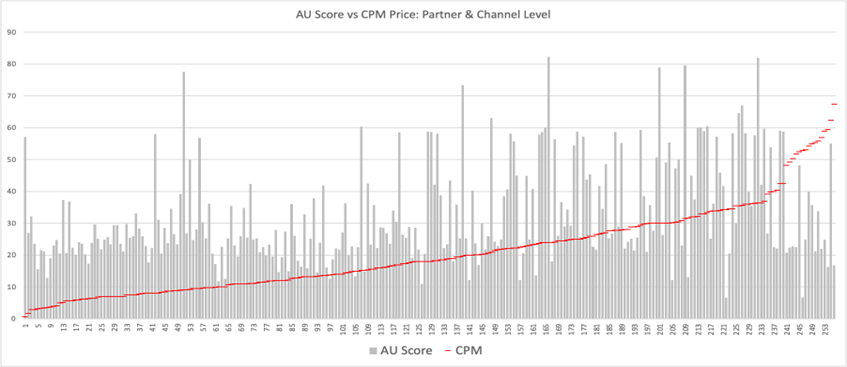The number of reboots, sequels and spinoffs are all evidence that culture is stuck, producing little innovation for all of the time consumers spend watching and listening. As Adelaide’s Marc Guldimann explains, one culprit is media metrics, which, in a race to the bottom toward lower-attention placements, inadvertently created incentives for low-quality content.
Have you noticed that our cultural landscape seems to be stuck on repeat? From Top Gun and Cobra Kai to Barney the Dinosaur, we’re bombarded with reboots of past entertainment franchises like never before.
Indeed, over a 25-year period, starting in 1993, the number of movie remakes, prequels, sequels, and spinoffs in the top 20 annual grossing films increased by 700% – and that’s as of 2018! Last year, The New York Times film critic A.O. Scott announced he was leaving his job after 23 years, with the quip, “I’m tempted to say that the sky is still falling, or falling again, and that it’s the same old sky.” For him, it was a way to express that “The cultural space in which the movies I care most about have flourished seems to be shrinking.”
But it’s not just movies and TV. Old songs now represent 70% of the US music market. Fashion hasn’t changed significantly in decades. (A time traveler from 2002 might think they’d never left, judging from all the cargo pants, hoodies and Crocs.) Everything from book covers to car design now appears increasingly homogeneous.
In short, our culture isn’t just shrinking, it’s stuck. Where decades of the past had their own distinct style, the last 20 years seem to bleed together.
There are numerous theories as to why. Some say the algorithms that curate our content are trained on existing content. The rise of streaming services is also seen as a common culprit, at least in the case of TV, film, and music. With an increasingly crowded battle for market share, it makes good business sense to serve products that already have an audience.
But another unseen factor may be contributing to this culture freeze: the broken media currencies used in marketing and advertising. Understanding, and addressing, this problem might just help unstick culture.
Simply put, companies face two fundamental questions when bringing a product to market:
- Will people pay for our product? Let’s call this Appeal Risk.
- Can we reach that audience to tell them about it? Let’s call this Reach Risk.
In decades past, the media landscape was homogenous. There were a limited number of formats on TV (:15s, :30s), radio (:30s, :60s), and print (full page). Buying media was never easy, but media quality was far more consistent, and Reach Risk was low.
This allowed advertisers to take a lot of risks with Appeal. Maybe you’re an aging boxer who would like to sell a single-temperature, plastic-encased griddle. Think that selling people rocks as pets might work? Want to produce an intergalactic opera about a farm boy and his caped, heavy-breathing, absentee father who cosplays as an evil space samurai? Knock yourself out.
Those days are long gone. Getting people to pay attention to ads has never been more unpredictable. Today, an advertiser has dozens of options for channels to reach a target audience – everything from retail media networks to programmatic cinema – and the average consumer is served between a few hundred and thousands of ads a day.
Unfortunately, the metrics used to measure the quality of all those impressions, such as viewability, have very little to do with actual quality. In advertising, just as in other markets, opaque quality fuels a race to the bottom, where sellers create as many placements as possible while advertisers focus on finding the lowest-cost impressions.
The resulting feedback loop dilutes the quality of media into ever lower-attention placements and, over time, causes price and quality to dislocate as many sellers draw a line at the experience they’re willing to subject their audience to, while others command premium prices without good reason.
The chart below uses AU, Adelaide’s widely-used, proprietary media quality score that blends attention metrics and outcome data to rate the quality of placements, and contrasts it with media cost. It illustrates the point that the cost of media isn’t predictive of quality.

But how do bad metrics actually slow down culture? Risk mitigation. When there are two types of risk in a system and one increases dramatically, rational actors will effectively trade off risk.
When Reach Risk is high, marketers seek to minimize Appeal Risk.
This hedge manifests as safe bets – sequels, remakes and cookie-cutter products. Thus the poor media metrics in use today may be incentivizing the production of safe, tried-and-tested, formulaic products over fresh, innovative ideas.
This is not to suggest that broken media metrics are the only thing holding back culture. There are other reasons that companies, or entire industries, tend to play it safe. The cost of producing movies, for example, has ballooned in recent years. Algorithms recommend things that were popular in the past and create things the same way.
Even so, more precise media quality metrics should help drive innovation. The same attention metrics that illustrated the dislocation between price and quality are being used by advertisers to more precisely measure media quality. According to survey data from DoubleVerify, approximately 60% of marketers say they employ attention metrics in at least some buys; an additional 36% say they use attention metrics in most buys.
Over time, as the predictability of media quality increases, brands should feel comfortable taking on more Appeal Risk and exploring more innovative content and product offerings. For those in the business of creating our culture, attention metrics will be a game changer. And maybe consumers will get the next Star Wars, instead of the next Star Wars sequel.

